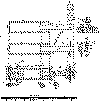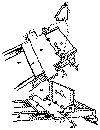By Dan Beard

Fig. 69:
Cup Winner and Crew
Now for the pushmobile; and since we are living in the age of flying-machines, telephones, electric railroads, subways, and all sorts of wonderful things, even pioneers must use these modern contrivances once in a while and I myself have seen an automobile full of painted and feather-decked Natives, so why not a Kit Carson Pushmobile?
The pushmobile, which has in certain cities been attracting the attention of the public and has also become a thing of absorbing interest to the small boys, is an invention of the small boys themselves.
The young inventors took their simple coasting wagons and transformed them into pushmobiles, displaying in their work both ingenuity and mechanical skill of a high order.
Some of the youngsters imitate all the peculiarities of real automobiles in their playthings; they fill an old oil-can with dry rags and leaves, set fire to them, and their pushmobile makes as much smoke with as objectionable an odor as the real racer: Other boys have a piece of tin so attached to the machine that it hits each spoke of one wheel as the latter revolves, making a noise so closely resembling an automobile as to startle timid pedestrians when crossing the streets.
Each pushmobile has a driver (pilot) and a mechanician (pusher). At the last Vanderbilt Cup Race at Flushing, Long Island, there were twenty-two of these queer machines entered, and almost all of them were painted a dull gray or lead color like the big automobile racers.
The "coolers" on some are made of bent wood, some of tin, some of cloth stretched tightly over a frame, others have a big oil-can or a keg on the front to represent the cooler, and almost all have the front of the cooler so painted as to look like the grating in the front of a real automobile. A few have wire screen fronts, and many, in imitation of the big machines, carry an extra wheel behind or in front.
The races for the silver Vanderbilt Cup are attended by a large crowd of grown people, and the big newspapers are all represented by their reporters busy with cameras and pencils to make reports of the event.
According to the newspaper reports:
Car No. 1, driven by Bondfelder and Rhinehardt, of College Point, finished second, five minutes later. The rest of the fourteen starters trailed along for the next half-hour.Flushing's first pushmobile race, on Saturday morning, November 17, I906, was a greater success than the promoters of the event anticipated. The fact that the grown people had encouraged the contest by a substantial contribution toward a prize silver cup added zeal to the contestants and also was responsible for much of the crowd which assembled at the course before seven o'clock yesterday morning.
Fourteen contestants took part in the race. The course was four and a half miles, being ten laps around the square bounded by Murray, Amity, and Botanic Streets and Broadway. The start was made at Murray Street and Broadway at seventeen minutes past seven o'clock. It was well done, all the boys getting off in good shape and being loudly cheered by the spectators. Paul Baumeister and M. Boyajian were the judges.
Car No. 11, driven by Harry Brown, Jr., and Austin Lawrence, shot across the tape of the Murray Hill pushmobile course at Flushing yesterday, winner of the Vanderbilt Cup for 1906.
The course was ten times around a city block, one and three fourths miles in length, and the winners did the distance in twenty-seven minutes and twelve seconds.
One hen, a cat, and a yellow dog were injured by the flying cars, but it is believed that another contest will be held next year.
The start was made at eight o'clock in the morning, the cars being sent away two minutes apart. All of them finished, although one lost a baby-carriage wheel in taking one of the street corners too fast.
When it was over the thirteen-year-old president of the Murray Hill Pushmobile Club sent this telegram to William K. Vanderbilt, Jr., who donated ten dollars for the cup:
"Race a great success. Wish you could attend banquet to the winner tonight. PAUL TOWNE."

Figs. 56-59
Details of Framework of Pushmobile
Select oak wood one inch thick by two inches wide and cut out the pieces A, A, B, and C (Fig. 56). Make B and C each fourteen inches long and fasten the frame together as in Fig. 56. Then take another piece, E, of the same material and cut it to fit between the side bars A and A and fasten it with screws at a point just one foot from C (Fig. 56).
Next saw out the reach-board D. Let it be of pine, one and one-quarter inches thick, five and one-half inches wide by two and one-half feet long (D, Fig. 56).
For the seat use a pine board seven and three-quarter inches wide, twenty-one inches long, and saw two pieces from the rear end so as to leave a projection on each side four inches wide (Q, Figs. 59 and 60). Then to this add the piece P three inches wide.

Figs. 59-60
Details of Folding Pusher
The coaster and pusher. O (Figs. 59 and 60) is hinged with a couple of flat iron hinges. To strengthen the pusher a couple of cleats or battens are fastened with screws to each side, as in the diagrams. To prevent the pusher from folding over and prying off the hinges, cut two stilt-blocks (S, Figs. 59 and 60), fasten them to the sides of the pusher 0, so that when the pusher is up (Fig. 60) the B blocks will rest upon the "rest" cleats R (Figs. 59 and 60).
The front wheels are sixteen inches in diameter; the rear eighteen inches, and must be stronger than the front.
The steering-wheel is made of a toy wagon's wooden wheel, but this of itself is not strong enough, and to add strength, as well as to keep it from turning on the shaft, run a small iron rod (Fig. 64) through a hole bored through the shaft, and fasten each end of the rod to the spokes of the wheel by binding it with a piece of copper wire (Fig. 68). The cooler is made of galvanized sheet-iron bent over a wooden frame (Figs. 61, 62, 63, and 64), and in it is the steering apparatus, shown by the X-ray view (Fig. 63).

Diagrams Giving the
Parts of a Pushmobile
The front wheels work upon an iron axle which comes with the wheels, and this is bolted to the wooden axle G, shown in Figs. 57 and 58. The wooden axle turns on a pair of fifth wheels, F, secured by a pin or king-bolt, which fits in a hole in the reach-board D and runs through the fifth wheels and down into the wooden axle. Bore the hole for the pin and drop it in; it is not necessary to fasten it there. To make the fifth wheels saw off the corners of a square piece of one-inch board; make it seven inches in diameter, F (Figs. 56, 57, and 58), cut a notch one-half inch deep and seven inches long in the top of the wooden axle G, and fasten one of the fifth wheels to the axle with screws in such a manner that the hole in the axle fits the hole in the center of the wheel; the other fifth-wheel is loose and is held in place by the king-bolt.
The hind wheels also have an iron axle, which is bolted by three bolts (L, Fig. 58) to a wooden axle made of a two-inch by three-inch piece of pine (see L in Fig. 58). The other parts of the framework consist of stilt-blocks M and M, the pieces H, J, and N, a spreader and a wooden frame for the front and rear of the cooler-box. Fig. 61 shows the rear frame of cooler; there is also a top piece in front, but the front frame is smaller than the rear end of the cooler.
The steering-gear consists of the wheel (Figs. 68, 63, and 69), a wooden shaft turning in a socket-hole in a wooden block (Z, Fig. 63) and supporting a spool, U, five inches in diameter (Figs. 63, 66, and 67), around which the chain K is looped, as shown by the diagram (Fig. 66). The ends of the chain run through screw-eyes in the sides of the reach-board over the block H (Fig. 66), and thence to the wooden front axle, where the ends are fastened by screws run through the links of the chain. Fig. 66 gives detail of the loop of the chain, showing its arrangements.
The chain is fastened to the top of the spool U by a screw; the part of the chain on the left-hand side of the spool crosses the part on the right-hand side in such a manner that the left-hand chain is attached to the right-hand side of the axle and the right-hand chain to the left-hand axle.
Make the spool of one-inch pine board and the flanges of one-half inch. Cut them like F (Fig. 56), then whittle off the corners until they are wheel-shaped.
A hole is bored through the rear frame of the cooler box (Fig. 61), at a point, W, midway between the two sides and about three and one-half or four inches below the top, through which the shaft is run to the socket hole in the front block Z; a hole also runs through the wedge-shaped block Y (Figs. 63 and 65), which is screwed to the inside of the front frame of the cooler and shown in the X-ray view (Fig. 63).
On each side of the cooler, eight and one-half inches back of the front, two deep notches are cut in the sheet-iron seven inches high and seven inches wide at the base (Figs. 63 and 69), to enable the wheels to move freely when turning sharply to one side or the other.
This pushmobile, when all finished, should weigh fifty-seven pounds.
The driver sits in the car and steers, the mechanician runs behind and pushes until he comes to a down grade, then he jumps aboard and rides.